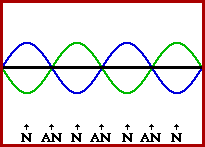What is a node? What is an antinode?
1 Answer
Node: A pont along a standing wave where the wave has minimum amplitude
Antinode: A point along a standing wave where the wave has maximum amplitude
Explanation:
A sinusoid, or sine wave, is "a mathematical curve which describes a smooth oscillation." https://en.wikipedia.org/wiki/Sine_wave
When two sine waves of the same frequency but opposite direction in the same medium interact with each other, it results in the interference phenomenon known as a standing wave. They occur when waves are reflected at a boundary, such as in a guitar string or organ pipe.
The node is a point along that wave where the displacement is the least. If both waves have the same amplitude, the node is always located at 0. If the waves have different amplitudes, they don't cancel out perfectly and so the node is as close to 0 as it can get. On a moving graph of a standing wave, the node is present at the places where the line seems to stay still, like so

http://www.physicsclassroom.com/mmedia/waves/swf.cfm
The distance between each node is equal to half a wavelength, or
The antinode is a point along the standing wave where the displacemnt is the greatest. It occurs halfway between each node, and so the distance between each antinode is also
"In transmission lines a voltage node is a current antinode, and a voltage antinode is a current node" https://en.wikipedia.org/wiki/Node_(physics)
In a fixed boundary situation, such as the end of a guitar string or a transmission line with the end short circuited, the node starts at the boundary, and the other nodes occur at multiples of
In a free boundary situation, such as at the ends of an antenna or the end of a tuning fork, the antinode starts at the boundary, which means the first node is
http://www.physicsclassroom.com/class/waves/Lesson-4/Nodes-and-Anti-nodes
I hope I helped!

